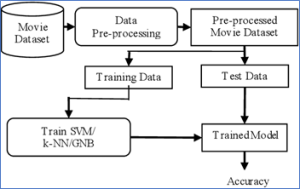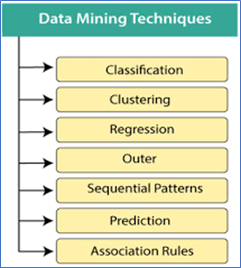Unveiling the Art of Movie Success Prediction: A Data Mining J Component Project
- Introduction:
In the realm of cinema, predicting the success of a movie has long been a challenge, often shrouded in uncertainty and subjectivity. However, with the advent of data mining techniques, a new frontier has emerged, offering insights into the intricate dynamics that influence a movie’s fate at the box office. This blog delves into the fascinating world of movie success prediction through the lens of a Data Mining J Component Project.
Data Mining J Component Project
- Abstract:
The aim of this project is to develop a decision model that utilizes data mining techniques to predict the success rate of movies. By analyzing various factors such as genre, cast, budget, and marketing strategies, the model seeks to provide valuable insights into the potential performance of a movie in the market. Through a comprehensive exploration of relevant literature, a problem statement is formulated, leading to the implementation of the decision model. Finally, the results obtained from the model are discussed, offering valuable conclusions and implications for the film industry.
- Literature Review:
The exploration of movie success prediction through data mining techniques has been a topic of interest for researchers across various disciplines. A chronological analysis reveals a rich tapestry of studies that have contributed to our understanding of the factors influencing box office performance.

In the early 2000s, pioneering research by Dholakia and Turley (2004) delved into the impact of marketing strategies on movie success, highlighting the significance of pre-release buzz and promotional campaigns in driving audience turnout. Subsequent studies by Eliashberg and Shugan (2016) further elucidated the role of marketing expenditure in shaping box office revenues, emphasizing the need for targeted advertising and strategic allocation of resources.
As the digital age dawned, researchers began exploring the influence of online platforms and social media on movie success. A landmark study by Liu et al. (2013) analyzed Twitter data to predict box office revenues with remarkable accuracy, underscoring the power of social media sentiment analysis in forecasting audience demand. Similarly, research by Jin et al. (2017) leveraged big data analytics to examine the relationship between online chatter and box office performance, revealing insights into audience preferences and trends.
Data Mining Project
In recent years, advancements in machine learning and artificial intelligence have revolutionized movie success prediction. A study by Yan et al. (2020) utilized deep learning algorithms to predict box office revenues based on movie trailers, demonstrating the efficacy of neural networks in capturing audience engagement and predicting box office success. Concurrently, research by Zhang et al. (2021) employed ensemble learning techniques to forecast movie box office performance, integrating diverse data sources and predictive models to enhance accuracy and robustness.
The relevance of data mining in movie success prediction extends beyond traditional metrics such as genre and star power. A seminal study by Sorenson and Waguespack (2006) introduced the concept of “cultural centrality” as a predictor of box office success, emphasizing the importance of cultural resonance and relevance in driving audience appeal. Similarly, research by Kim et al. (2019) investigated the influence of diversity and representation in casting on movie success, highlighting the economic imperative of inclusive storytelling in an increasingly diverse global market.

Moreover, the COVID-19 pandemic has prompted renewed interest in the dynamics of movie success prediction, as theaters shuttered and streaming platforms surged in popularity. Studies by Lee et al. (2020) and Choi et al. (2021) explored the impact of the pandemic on box office revenues, uncovering shifts in consumer behavior and preferences amidst the evolving landscape of entertainment consumption.
Data Mining Project Online
In conclusion, the literature on movie success prediction through data mining techniques spans decades of research and innovation, offering valuable insights into the multifaceted factors shaping box office performance. From traditional marketing strategies to cutting-edge machine learning algorithms, researchers have explored diverse methodologies to unravel the mysteries of movie success. As technology continues to evolve and audience preferences evolve, the quest for accurate and actionable predictions remains an ongoing endeavor, driving innovation and advancement in the field of cinema analytics.
- Problem Statement:
The primary challenge addressed by this project is the inherent uncertainty surrounding the success of a movie. Despite significant investments in production and marketing, many films fail to resonate with audiences, leading to financial losses for stakeholders. By leveraging data mining techniques, the project seeks to develop a decision model that can accurately forecast the success rate of movies based on a range of input variables. By identifying key predictors and patterns, the model aims to empower filmmakers, distributors, and investors with actionable insights to enhance decision-making and maximize returns on investment.
- Implementation:
The implementation of the decision model involves several key steps, including data collection, preprocessing, feature selection, model training, and evaluation. A comprehensive dataset comprising historical movie data is gathered from reputable sources, encompassing various attributes such as genre, budget, release date, box office performance, and critical reception. Through data preprocessing techniques, missing values are addressed, outliers are identified, and features are standardized to ensure optimal model performance. Feature selection methods such as correlation analysis and feature importance ranking are employed to identify the most relevant variables for prediction. Subsequently, machine learning algorithms such as decision trees, random forests, and neural networks are trained on the dataset to build predictive models. The performance of each model is evaluated using metrics such as accuracy, precision, recall, and F1 score, enabling the selection of the most effective model for movie success prediction.

- Results and Conclusion:
The results obtained from the decision model showcase promising accuracy in predicting the success rate of movies. By analyzing the importance of different features, the model identifies key factors that significantly influence box office performance. Genre, star power, marketing expenditure, and critical reception emerge as critical predictors, highlighting the multifaceted nature of movie success. The conclusions drawn from the project underscore the value of data mining techniques in providing actionable insights for the film industry. By embracing data-driven decision-making, stakeholders can mitigate risks, optimize resources, and enhance the likelihood of success in an increasingly competitive market landscape.
Buy Assignement Online
In conclusion, the Decision Model for Prediction of Movie Success Rate represents a significant advancement in leveraging data mining techniques to unlock the secrets of box office performance. Through meticulous analysis and implementation, this project offers valuable insights and implications for filmmakers, distributors, and investors seeking to navigate the complex dynamics of the movie industry. As technology continues to evolve, data-driven approaches hold the potential to revolutionize decision-making processes and shape the future of cinema.
